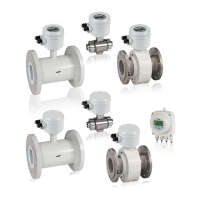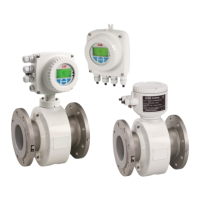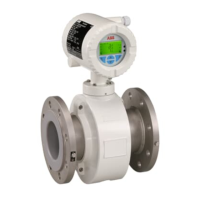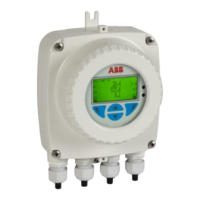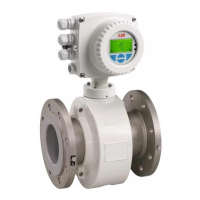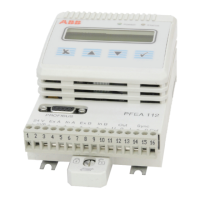30 FEP630, FEH630 ELECTROMAGNETIC FLOWMETER | OI/FEP630/FEH630-EN REV. D
… 6 Electrical connections
… Sensor grounding
Metal pipe with fixed flanges
G12021
1
1
AB
A Flange design
B Wafer type design
1 Ground terminal
Figure 34: Metal pipe, without liner (example)
Use a copper wire [at least 2.5 mm
2
(14 AWG)] to establish the
connection between the ground terminal of the sensor, the
pipeline flanges and a suited grounding point in accordance with
the figure.
Metal pipe with loose flanges
G12022
1
1
2
2
AB
A Flange design
B Wafer type design
1 Threaded bolts M6
2 Ground terminal
Figure 35: Metal pipe, without liner (example)
1. Solder the threaded bolts M6 to the piping and connect the
ground in accordance with the figure.
2. Use a copper wire [at least 2.5 mm
2
(14 AWG)] to establish
the connection between the ground terminal of the sensor
and a suited grounding point in accordance with the figure.
Plastic pipes, non-metallic pipes or pipes with insulating
liner
G12023
2
1
1
3
AB
3
2
A Flange design
B Wafer type design
1 Ground terminal
2 Terminal lug
3 Grounding plate
Figure 36: Plastic pipes, non-metallic pipes or pipes with insulating liner
For plastic pipes or pipes with insulating lining, the grounding of
the measuring medium is provided by the grounding plate as
shown in the figure below or via grounding electrodes that must
be installed in the device (option).
If grounding electrodes are used, the grounding plate is not
necessary.
1. Install the sensor with grounding plate in the piping.
2. Connect the terminal lug of the grounding plate and ground
connection on the sensor using the grounding strap.
3. Use a copper wire with at least 2.5 mm
2
(14 AWG)) to
establish a connection between the ground connection and a
suited grounding point.

